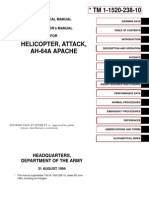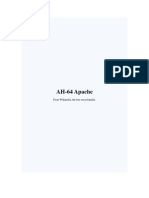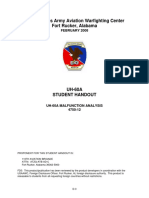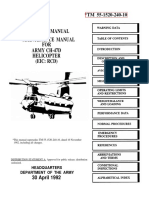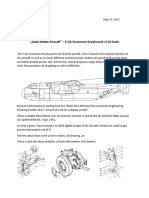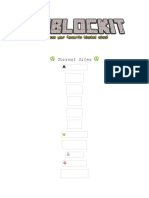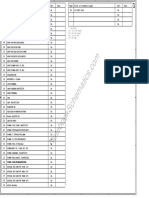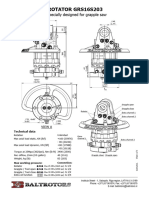UH-60 L Booklet
UH-60 L Booklet
Uploaded by
cho kang hoCopyright:
Available Formats
UH-60 L Booklet
UH-60 L Booklet
Uploaded by
cho kang hoOriginal Description:
Copyright
Available Formats
Share this document
Did you find this document useful?
Is this content inappropriate?
Copyright:
Available Formats
UH-60 L Booklet
UH-60 L Booklet
Uploaded by
cho kang hoCopyright:
Available Formats
UH-60L BLACKHAWK
QUALIFICATION
FAMILIARIZATION HANDBOOK
AND
PROGRAM OF INSTRUCTION
2
UH-60L FAMILIARIZATION HANDBOOK
1. INTRODUCTION
a. The UH-60L helicopter is the same as the UH-60A helicopter except:
1. T700-GE-701C engines replace T700-GE-700 engines.
2. The Main Transmission (28000 series) is replaced by an Improved Durability
Gearbox (38000 series).
3. A Digital Electronic Control (DEC) replaces the Electrical Control Unit (ECU).
4. An Overspeed Drain Valve (ODV) replaces the Pressurizing Overspeed Unit
(POU).
5. A History Counter replaces the History Recorder.
6. An additional Nr sensor and Collective Position Transducer have been added
to work with Transient Droop Improvement.
7. A VH-60 Central Display Unit (CDU) and VH-60 Signal Data Converters
(SDC) support the functions of the T70-GE-701C engines.
2. T700-GE-701C ENGINES (2)
a. Specifications
1. Dry weight: 456 pounds
2. Length: 47 inches
3. Diameter: 25 inches
4. RPMs
a. 100% Ng: 44,700 RPM
b. 100% Np: 20,900 RPM
5. Shaft Horsepower (SHP) Sea Level, Standard Day, 20,900 RPM (100%
Np)
a. Maximum Continuous: 1662 SHP
b. Intermediate (30 min): 1800 SHP
c. Maximum (10min): 1890 SHP
d. Contingency (2.5 min): 1940 SHP
3
b. The T700-GE-701C engine is derived from the T700-GE-700 engine (85%
common parts) with aerothermodynamic improvements necessary to achieve an
approximate 20% increase in maximum power. The engine maintains the same
basic structure and configuration. Improvements were made primarily in the
Compressor Rotor Assembly, the Hot Section Module, and the Power Turbine
Module.
1. Compressor Rotor Assembly: Changes enhance performance and
provides additional ventilation to the #4 bearing.
a. Centrifugal Impeller and new Rectangular Throat Diffuser: Centrifugal
Impeller backwall thickness increased for compatibility with new
diffuser. The new diffuser reduces the speed of the airflow more than
the GE-700 diffuser, resulting in greater air compression and air
temperature entering the combustion chamber. The more efficient
use of induced airflow results in better engine response to demands.
b. Compressor Rear Shaft/Gas Generator Shaft: Center vent holes in
the rear shaft relocated aft of the compressor/turbine spline, and one
half of the spline teeth have been removed to allow B-sump vent air to
flow under the #4 bearing journal significantly reducing the bearings
operating temperature. Two vent holes have been added to the Tie
Rod Locknut, allowing some fourth stage air to leak along the tie rod
threads to purge oil, preventing locknut seizure.
2. Hot Section Module: Improved materials and increased part cooling
efficiency allow an increase in operating temperature. Selected durability
changes for continued field reliability and maintainability.
a. Stage One Turbine Nozzle:
1. Nozzle Segments (12): The two vanes in each segment are
welded together for a stronger joint than brazing (GE-700).
2. New Material: More heat resistant, improved strength, and better
corrosion resistance (vanes and support structure).
3. New Aerodynamic Design: Provides a better airflow onto the first
stage turbine blades.
4. Nozzle Support Ring: One piece cast vs. two pieces in the GE-
700. Eliminates a leakage path between two parts. Also
incorporates a more heat resistant material. Improvements
enhance quality feed.
b. Gas Generator Turbine Rotor:
1. New Material (DRS 108): Turbine blades, disks, and cooling
plates more heat resistant.
4
2. New Aerodynamic Design: Increased the curvature of the leading
edge of the blades. Provides a more efficient use of the hot gases
passing across each airfoil.
3. Serpentine Drill: Significant convection and film cooling
improvements of turbine blades. Cooling air is turbulated
throughout internal structure of both stages vs. only the leading
edge of the first stage in the GE-700. Cooling air is provided by
compressor discharge air.
4. Under Platform Blade Dampers: Under first stage blades to
preclude vibratory problems.
c. Gas Generator Stator:
1. Stage Two Nozzle Assembly:
a. Nozzle Segments (13): The two vanes of each segment are
welded together for a stronger joint than brazing.
b. New Material: More heat resistant and improved strength.
c. New Aerodynamic Design.
d. Serpentine Drill: Turbulated airflow throughout inner structure.
Internal cooling air from two sources vs. one source in the GE-
700 (Compressor Discharge Air/Impeller Tip Leakage Air vs.
only Impeller Tip Leakage Air).
2. Stage One/Two Shrouds:
a. Solid state steel vs. Bradelloy filled honeycomb more heat
resistant and improved strength.
b. Increased the number of segments for both stages. This
reduces thermal curl therefore eliminating localized blade tip
rubs (14/12 vs. 6/6).
3. Interstage Seal:
a. Material changed to a low coefficient of expansion material.
b. Welded-in-place locating pins replaced with a nut/bolt design
increased durability and easier replacement.
3. Power Turbine Module:
a. Power Turbine Casing: One piece cast Uniformity of heating and
cooling, reduces cracking.
b. Radiation Shields/Insulators: Added for cooler casing operations.
c. Stage Three Blades: Material changed for increased stress rupture
life.
d. Stage Three Turbine Nozzle: One piece cast vs. Multi-part assembly.
e. C-Sump Housing:
1. One piece design.
2. Addition of C-Sump Cover Oil Jets: Reduces cover temperature
and extends O Ring Seal life.
3. Replaceable forward oil jet for ease of replacement at depot level.
5
f. Exhaust Frame: One piece cast.
g. Impingement Cooling Shroud: Two piece stainless steel cooling cowl
cools casing skin using engine bay air drawn through impingement
holes. Air is then ejected into the main gas stream.
c. Other Modifications:
1. Improved Anti-Ice Start Bleed Valves.
2. Improved Start Control Valves.
3. Improved Cross Bleed Valves.
4. Structurally Improved Engine Mounts.
3. DIGITAL ELECTRONIC CONTROL (DEC)
a. The DEC replaces the analogue ECU. The DEC contains a micro-computer
processor in a conductive composite molded case. It is mounted below the
compressor casing in the same location as the ECU. The DEC does not have an
insulation blanket and is cooled entirely by airflow through the scroll case. It
provides the same basic functions as the ECU.
b. Two (2) Power Sources:
1. Primary: Engine Alternator.
2. Secondary: 400 Hz, 120 Vac Airframe Power.
3. Complete loss of engine alternator will only result in a loss of Ng signal (with
corresponding engine out audio and light). Airframe power will sustain the
DEC and there should be NO failure of the engine to the high side, or loss of
TQ and Np indications.
c. Accepts inputs from other sources for electronic control of the engine:
1. Engine Alternator.
2. Thermocouple Harness.
3. Np Sensor.
4. Torque and Np Overspeed Sensor.
5. Torque signal from the other engine.
6. Collective Position Transducer (New mounted in the mixing unit).
7. Nr Sensor (New mounted on left Accessory Module).
8. Demand Speed from Engine Speed Trim Switch.
9. Feedback signal from the Hydromechanical Unit (HMU) for system
stabilization Linear Variable Differential Transformer (LVDT).
d. Provides the following signals to the cockpit:
1. Np Initial indication is at 4000 RPM vs. 6000 RPM with the ECU. Permits
earlier signal during engine runup.
2. Torque Torque signal locked to zero until Np reaches 35%. This logic
eliminates torque spike signal during engine start and shutdown. This
prevents yaw excursions caused by load sharing response to torque spike
during inflight restart of an engine.
6
3. TGT (T4.5) 71C Bias (Engine is running hotter than indicated on the
CDU).
4. Signal Fault Validation:
a. Validates selected input signals and DEC functions continuously when
engine is running.
b. If a signal failure occurs it will be identified by a preselected fault code
that will be displayed on the torque meter digital readout after engine
shutdown. Fault codes are in numerical format in increments of 10%
ranging from 15% to 125% (+/- 3% tolerance).
c. Display will start with the lowest code then rotate through all activated
codes in numerical sequence, then repeat the cycle. Codes are locked in
until the problem is corrected and the engine is started again.
d. For a code to be valid it must remain on for 4 seconds. Each code is
displayed 4 seconds on, 2 seconds off, in numerical sequence.
e. Fault codes can be suppressed by pressing either of the Np overspeed
test buttons (A or B) located on the Overhead Console. They can be
recalled by again pressing one of the Np overspeed test buttons.
f. Codes will be displayed 30 seconds after the conditions listed below have
been met:
1. Ng < 20%.
2. Np < 35%.
3. Airframe 400 Hz, 120 Vac power is available.
g. Codes will be displayed as follows:
SIGNAL FAILED INDICATION ON TORQUE METER (+/-3%)
DEC 15%
Np Demand Channel 25%
Load Share Channel 35%
TGT Channel 45%
Alternator Power 55%
Ng Channel 65%
Np Channel 75%
Torque and Overspeed Channel 85%
Hot Start Prevention Channel 95%
Aircraft 400 Hz Power 105%
Collective Channel 115%
Nr Channel 125%
e. Additional/Modified Operational Features:
1. Hot Start Preventer (HSP):
a. Automatically prevents overtemperature during engine starts by shutting
down the engine.
b. Requires 400 Hz, 120 Vac power for operation.
c. Requires signals from the Np sensor, Ng Winding, and the Thermocouple
Harness (TGT).
7
d. HSP activates a solenoid in the ODV which shuts off fuel flow to the
engine when Np and Ng are below their Hot Start Reference Values and
the TGT exceeds its reference value.
1. Ng < 60%.
2. Np < 50%.
3. TGT > 900C.
e. Pilot then places Engine Power Control Lever OFF and turns ignition off.
f. Before attempting a restart the TGT must decrease below 300C or wait
25 seconds.
g. In an emergency HSP can be disabled by pressing and holding either of
the Np overspeed test buttons during the start. To ensure the system is
disabled throughout the full start sequence, hold button in until Ng > 60%.
2. Load Sharing:
a. Uses the torque signal from the other engine (same as the ECU).
b. Increases power on the lower engine without affecting the high power
engine.
c. System will increase Np 3% above reference Np to satisfy torque
matching.
3. Transient Droop Improvement (TDI):
a. Engines more responsive to aircraft maneuvers by providing a collective
and Nr rate compensation.
b. Signals required:
1. New Nr Sensor mounted on the left Accessory Module.
2. New Collective Position Transducer mounted with two previous
transducers on a modified bracket assembly in the mixing unit.
3. Engine torque signal.
c. The Nr and collective signals are routed to rate circuits in the DEC and
compared with Np and TRQ signal values. When the Nr and collective
rate signals exceed predetermined values they are combined and passed
to the Torque Motor Amplifier. A large Nr drop rate, and a significant
increase of collective both result in a greater input signal. A priority signal
is then processed to quickly trim the Torque Motor in the HMU to
compensate for the demand.
d. Transient Droop Improvement is 4:1 over the T700-GE-700 engine.
e. If a sensor fails or a malfunction occurs then the system reverts back to
the basic load demand system similar to that provided by the ECU.
4. TGT Limiting:
a. Dual Engine Limiting Value: 866 +/- 6C.
b. Contingency Power Limiting Value: 891 +/- 5C (OEI).
1. Automatic contingency power is provided by the DEC by resetting the
TGT Limiting to a higher value.
2. When other engine is inoperative (engine failure or torque split).
3. When torque on other engine is below 50%.
4. Provides more power of single engine operation (approximately 5%).
8
c. The DEC commands the HMU to limit fuel flow to the engine when TGT
reaches the limiting value.
d. TGT Limiting does not prevent overtemp during compressor stalls, engine
starts, or when the engine power control lever is in LOCKOUT.
e. When maximum power is demanded transient increases above the
limiting values can be expected to occur.
5. Np Overspeed Protection System:
a. Primary electrical source is the engine alternator and the secondary
source is 400 Hz, 120 Vac airframe power.
b. System is tripped when Np reaches 120% +/- 1% (25,000 RPM).
c. System requires an input signal from the Torque and Np Overspeed
Sensor located at the 1:30 position on the exhaust frame.
d. When an overspeed is sensed by both Overspeed Sensing Circuits A and
B, the Overspeed Protection Relay will activate the Overspeed Solenoid
in the ODV, and sends a signal to the Delay On Drop Out (DODO) Circuit
to turn on the ignition.
e. ODV shuts off all fuel to the engine causing it to flame out (Overspeed
Solenoid Valve opens and all fuel is cycled back to the HMU).
f. When Np drops below 120% +/- 1%, the Overspeed Solenoid Valve
automatically closes allowing fuel flow to return to the engine.
g. When the Overspeed Solenoid Valve closes, resupplying fuel to the
engine, ignition will come on (channeled through the Overspeed Relay)
and remain on for 5 seconds to allow for restart.
h. Np Overspeed Test System operates in the same manner as with the
ECU.
i. Np Overspeed Protection is still functional during DEC lockout operations.
6. DEC Lockout:
a. In case of a DEC malfunction, operation of the system may be over-
ridden by momentarily advancing the Engine Power Control Lever to the
LOCKOUT position (130 degree position).
b. Procedures are the same as with the ECU.
7. Engine Trim:
a. Resettable Np Reference: 96% to 100.5%.
b. Controlled by the Engine Speed Trim Button located on the collective.
8. History Counter:
a. Replaces the History Recorder (not interchangeable).
b. Requires either engine alternator or 400 Hz, 120 Vac airframe power.
c. All computations are conducted in the DEC.
d. Provides a permanent record of engine parameters.
1. Engine Operating Hours Begins counting when Ng reaches > 50%.
2. Low Cycle Fatigue (LCF) 1 Mechanical stress Ng exceeds 95%
after being greater than 50%.
9
3. LCF 2 Thermal Stress Ng exceeds 95% after being greater than
86%.
4. Time Temperature Index Indicates when TGT reaches 90% of
maximum continuous value (approx. 770C).
e. In addition to the four history counts displayed by the History Counter, the
DEC internally tracks several other key indicators on engine history.
These can be accessed by the S39 test connector and special
equipment. All information is stored in DEC memory for 5 previous
flights.
f. History computations require inputs from Np, Ng, and TGT. If any of
these sensors fail all computations will stop.
4. OVERSPEED DRAIN VALVE (ODV)
a. Replaces the Pressurizing Overspeed Unit (POU).
b. Mounted on the rear of the accessory section of the engine (same location as the
POU).
c. Houses two (2) main valves and the Overspeed Solenoid Valve.
d. Has three (3) primary functions:
1. Sends fuel through main fuel manifold to the 12 main injectors for starting
acceleration and engine operations. No start fuel manifold or primer nozzles
on the 701C.
2. Purges fuel from the main fuel manifold on shutdown to prevent coking.
3. Np Overspeed Protection/Hot Start Preventer Recycles all fuel back to the
HMU inlet, shutting off entire fuel flow to the engine.
5. MAIN TRANSMISSION SYSTEM
a. Improved Durability Gearbox (38000 series) replaces the 28000 series
transmission of the UH-60A.
1. An in-production gearbox for the Navy Seahawk modified slightly for the
Blackhawk.
2. The IDGB was designed for two reasons:
a. Increased horsepower rating from 2828 HP to 3400 HP.
b. Improvements to failure modes experienced in the field.
3. Increased Single and Dual Engine rating (however, the main transmission will
maintain the UH-60A Dual Engine 2828 rating so as to ensure other
component lives are not degraded).
4. Future growth capability for dual engine operation.
5. The IDGB includes the Navy Corrosion Control Package (completely
marinized) which will lower overhaul costs and improve maintainability.
b. Major Improvements:
1. New Upper Housing which includes a provisional mount for an additional
hydraulic pump.
2. Tail Take-Off Flange has a larger pinion shaft.
3. Provisions for a Rotor Brake.
4. Oil Filler Cap and Dip Stick are located further toward the front of the
gearbox.
10
5. All internal gears are upgraded. Plating also applied for better durability.
Planetary bearings (largest reasons for removals) were replaced with
bearings having a 62% increase in load capacity.
6. The IDGB mast shaft life will increase at least five fold from the current
1000/1300 hour life. Thrust bearing changed from a ball bearing to a roller
bearing.
7. Large increase in lube/scavenge volumetric flow.
a. New Sump with re-ported oil passage.
b. Improved oil pumps that provide better scavenge.
c. Oil filter houses 75 micron and 3 micron screens.
8. Breather ports installed on upper housing.
c. Specifications
1. Existing:
a. Dual Engine: 2828 HP
b. Single Engine: 1900 HP
2. Proposed:
a. Dual Engine: 3400 HP
b. Single Engine: 1900 HP
6. UH-60L ADDITIONAL INFORMATION
a. All mission kits designed for the UH-60A will be adaptable to the UH-60L.
1. External Stores Support System (ESSS).
2. Extended Range Fuel System (ERFS).
3. Multiple Delivery Mine System (VOLCANO).
7. LIMITATIONS/PERFORMANCE PLANNING DATA
a. Limitations established in Chapter 5 of TM 55-1520-237-10 apply with the
following changes:
1. Engine Torque:
a. Dual Engine Continuous:
1. 80 KIAS and below:
a. 0 to 120%.
2. Above 80 KIAS
a. 0 to 100%.
b. Dual Engine Transient:
1. 80 KIAS and below:
a. 120 to 144% (10 seconds).
2. Above 80 KIAS:
a. 100 to 144% (10 seconds).
11
c. Single Engine Continuous:
1. 0 to 135%.
d. Single Engine Transient:
1. 135 to 144% (10 seconds).
2. TGT Limits:
Normal 0to 810C.
30 Minute Limit 810to 851C.
Start Abort Limit 851C.
10 Minute Limit 851to 878C (866+/- 6C TGT Limiting).
2.5 Minute Limit 878to 903C (891+/- 5C TGT Limiting).
10 Second Transient 903to 949C.
3. Engine Oil Pressure Limits:
a. Minimum 22 psi.
Idle 22 to 26 psi.
Normal 26 to 100 psi.
5 Min. Limit 100 to 120 psi.
Maximum 120 psi.
b. B Sump Delta Pressure read by a variable reluctance transmitter.
1. Referenced to B Sump scavenge pressure.
2. Pressure indicated is B Sump differential pressure oil sump supply
pressure minus B Sump scavenge pressure.
3. B Sump pressure higher than other sumps.
4. System provides earlier warning of low oil to all sumps.
4. Main Transmission Oil Temperature:
Continuous -50to 105C.
Precautionary 105to 140C.
Maximum 140C.
5. Additional Information:
a. High altitude start above 17,000 ft PA may not be successful.
b. Proposed changes:
1. Np 10 Second Transient: 105% to 121%.
2. RPM R Transient (Power On): 101% to 121%.
6. New Central Display Unit:
a. Fuel TOTAL changed to MAIN.
b. Incorporates new TGT Limits.
c. Incorporates new Engine Oil Pressure Limits.
12
d. Does not indicate new Main XSMN Oil Temp Limits.
e. Not interchangeable with the UH-60A.
b. Performance Planning Data (L Model data listed in Chapter 7A of 10.
1. UH-60L Clean Configuration:
a. Fixed provisions for the External Stores Support System.
b. Main Rotor Deice System installed.
c. Mounting brackets for IR Jammer and Chaff Dispenser.
d. The Hover Infrared Suppressor System (HIRSS) with baffles installed.
e. Wire Strike Protection System installed.
2. With engine bleed air on torque available is reduced by:
a. Engine Anti-Ice On: -18%.
b. Cockpit Heater On: -4%.
c. Both On: -22%.
3. When the HIRSS is in the benign mode (exhaust baffles removed) torque
available is increased approximately 1% from that indicated on the charts.
4. When computing fuel flow utilizing Cruise Charts or Single/Dual Engine Fuel
Flow (Fig 7A-37), adjust burn rate as follows:
a. Eng. Anti-ice On: Dual Eng. +100 lbs/hr. Single Eng. +50 lbs/hr.
b. Cockpit Heater On: Dual Eng. +12 lbs/hr. Single Eng. +6 lbs/hr.
c. Both On: Dual Eng. +112 lbs/hr. Single Eng. +56 lbs/hr.
d. HIRSS removed: Dual Eng. -14 lbs/hr. Single Eng. -7 lbs/hr.
e. Chart is based on 0C so increase/decrease fuel flow 1% for every 20C
of temperature deviation.
13
UH60L FAMILIARIZATION FLIGHT TRAINING
Familiarization flight training will be conducted after the completion of academic
instruction. UH-60L preflight, engine-start, engine-runup, normal flight tasks, engine-
shutdown, and essentially all emergency procedures are performed identical to that of
the UH-60A. Modified tasks include performance planning and the emergency
procedure for a torque split. These modifications are discussed during the academic
phase of instruction. The ground and flight demonstrations listed below are necessary to
discern features that vary from the UH-60A helicopter.
GROUND DEMONSTRATIONS
1. Task: Demonstrate Preflight Inspection.
Conditions: Given a UH-60L helicopter and TM 55-1520-237-CL.
Standards:
a. Without error, perform the preflight inspection according to TM 55-1520-237-CL.
b. Correctly enter appropriate information on DA Form 2408-12 and DA Form 2408-
13.
c. Show and discuss exterior changes unique to the Control Access, T700-GE-
701C Engine, and the Improved Durability Gearbox.
Description: The preflight is conducted in the same sequence as with the UH-60A
with no change in the items to be inspected. However, items listed below are to be
shown and discussed.
a. Control Access:
1. Additional Collective Position Sensor mounted on a modified bracket in the
mixing unit.
2. Additional Nr Sensor mounted on the left accessory module.
b. T700-GE-701C Engine (sequence shown is from front to rear):
1. History Counter.
2. B Sump Delta Oil Pressure Sensing System.
3. Fuel Filter.
4. Overspeed Drain Valve (ODV).
5. Anti-Icing and Start Bleed Valve.
6. Digital Electronic Control (DEC).
7. Lack of Start Fuel Manifold and Nozzles.
8. Impingement Cooling Shroud.
9. Power Turbine Housing (One Piece Cast).
10. Structurally Improved Engine Mounts.
c. Improved Durability Gearbox (Main Transmission):
1. Takeoff Drive for additional Hydraulic Pump.
2. Rotor Brake provisions.
3. Oil level dip stick and filler port rotated further forward on main module.
4. Transmission oil filter canted forward.
14
2. Task: Demonstrate Engine Start, Run-up and Before Takeoff Checks.
Conditions: In a UH-60L helicopter with TM 55-1520-237-CL.
Standards:
a. Without error, perform procedures and checks according to TM 55-1520-237-CL.
b. Discuss features unique to the UH-60L that apply during this task.
Description: This task has not changed from that of the UH-60A. However, the
items listed below should be discussed while performing this task.
a. Prior to Starting Engines:
1. Identify and discuss the UH-60L Dual-Engine Torque Limits Placard
(techniques of interpolation) (if installed).
2. Pilot Display Unit (does not accurately reflect UH-60L single engine limits).
3. Central Display Unit (XSMN Oil Temp, ENG Oil Press, TGT, and Fuel Label).
4. After APU Generator is placed on line pull out the #1 OVSP circuit breaker.
a. Note lack of T4.5 bias (TGT increases 71C).
b. Leave circuit breaker out throughout start sequence. After 100% Np is
reached reset circuit breaker. This should activate signal fault codes 95
and 105, which will be displayed on the Torque Gauge after engine
shutdown.
5. Discuss Hot Start Preventer (HSP).
6. Abort-Start criteria and parameters remain the same as with the UH-60A
except the TGT Abort-Start limit is now 851C versus 850C.
b. Starting Engine:
1. Take note - NO torque spike.
2. Rapid start acceleration (all fuel provided by 12 main fuel nozzles).
3. Earlier Np indication (4000 RPM vs. 6000 RPM in UH-60A).
4. No Torque indication until Np reaches 35%.
15
3. Task: Demonstrate DEC Lockout Operations.
Conditions: In a UH-60L helicopter with an IP or SP, for the purpose of
demonstration.
Standards: Do not exceed TGT, Np, Nr, or Ng limitations.
Description:
This task is performed in the same manner and for the same purpose as with the UH-
60A. The purpose of this demonstration is to show that there is no difference in the
procedure and uniquely to show there is no overspeed protection at 106 + 1% Np. After
the selected engine has been placed to DEC lockout and the engine is under control,
advance the Engine Power Control Lever until Np reaches 108%. Point out no
overspeed protection. Do not exceed the 10-second operating limit in this range. After
completing the demonstration return the Engine Power Control Lever to the idle detent in
order to allow the DEC to regain control of the engine.
4. Task: Demonstrate Np Overspeed Protection.
Conditions: In a UH-60L helicopter on the ground with an IP or SP, and both
engines at 100% for the purpose of demonstration.
Standards:
a. Discuss Np overspeed protection prior to demonstration.
b. Do not exceed aircraft limitations.
Description:
This demonstration will be performed utilizing the A and B OVSP test buttons located
on the upper console. In the Overspeed Test mode the limit value is reset from 120 +
1% to 100%. Discuss the Np Overspeed Protection System. Direct the pilot's attention
to the selected engine's Np, TRQ, TGT, and Ng indications. Press the A OVSP test
button. Nothing should happen for both circuits must detect the overspeed for the
system to respond. After releasing the A button press the B OVSP test button. Nothing
should happen for the same reasons as already mentioned. Simultaneously press both
A and B OVSP test buttons. The DEC will send a signal to the ODV to remove all fuel
from the engine, momentarily shutting it down. There will be a significant decrease in
Np, TRQ, TGT, and Ng. Once the buttons are released automatic relight takes place
and the Np, TRQ, and Ng return to normal indications. TGT will increase to
approximately 100C above that indicated prior to the test, then returns to the original
indication.
16
FLIGHT DEMONSTRATIONS
1. Task: Demonstrate TGT Limiting.
Conditions: In a UH-60L helicopter with an IP or SP, Day, VMC.
Standards:
a. Discuss TGT Limiting System prior to the demonstration.
b. Do not exceed aircraft limitations.
Description:
Discuss the TGT Limiting System highlighting the difference between the Dual and
Single Engine Limiting Values. Establish level flight and increase collective until TRQ
indicates approximately 95%. Adjust airspeed to maintain level flight. With the other
pilot on the controls, smoothly retard the Power Control Lever on the selected engine
until the other engine reaches the dual-engine TGT limiting value 866 + 6C (do not
retard PCL below 50% TRQ otherwise the DEC will reset the limiting value to the single
engine value). Direct the pilot's attention to the TGT limit and the maximum torque that
is being provided by that engine. Also show the pilot that the engine is now operating in
the 10-minute range for TGT. Have the pilot maintain collective at present position and
retard PCL until TRQ decreases below 50%. TGT on the other engine should now be at
the single-engine limiting value 891 + 5C. Again direct the pilot's attention to the TGT
Limit and the maximum TRQ that is being provided by that engine. Show the pilot that
the engine is now operating in the 2.5 minute contingency range for TGT. If collective is
increased beyond this point the rotor and engines will decay in RPM. After completing
the demonstration return the PCL to the FLY detent.
Notes:
a. Recommended altitude is 1000 ft AGL.
b. Monitor TRQ, TGT, and Ng ensuring no limitations are exceeded.
c. The Engine Anti-Ice switch on the full power engine may be turned on to raise
the TGT sufficiently that TGT limiting may be encountered.
d. Compare torque values encountered during TGT limiting with that predicted on
the PPC.
17
2. Task: Demonstrate Transient Droop Improvement.
Conditions: In a UH-60L helicopter with an IP or SP, Day, VMC.
Standards:
a. Discuss Transient Droop Improvement prior to the demonstration.
b. Maintain entry altitude + 100 ft.
c. Maintain entry airspeed 100 + 10 KIAS.
d. Recovery altitude no less than 200 ft AGL.
e. Do not exceed aircraft limitations.
Description:
Discuss Transient Droop Improvement prior to performing the demonstration.
Establish the aircraft in level flight at an altitude sufficient for recovery at termination.
Airspeed should be 100 KIAS. Initiate a minimum power descent (collective full down).
Ensure the aircraft is in trim. Place the aircraft into a left bank to increase the rotor RPM
causing a Nr and Np split (the rotor and engines are decoupled at this point and the rotor
is in a power off state). Allow rotor to build to approximately 106%. At this time
smoothly increase collective. Direct the pilot's attention to the engine RPMs as they
accelerate to match the rotor RPM. When the engines reach the rotor's RPM they again
couple. As the collective is further increased a droop will occur. However the droop will
take place for the most part above the 100% mark. Droops down to 98% to 97% are
normal. Sufficient collective should be applied to ensure termination of the maneuver by
200 ft AGL.
Notes:
a. Recommended altitude is 1500 ft AGL.
b. Ensure engine RPM, TRQ, and Nr limits are not exceeded.
18
NOTES
You might also like
- TM 1-1520-237-PMI - Helicopter - EH-60 - UH-60 - 2005Document137 pagesTM 1-1520-237-PMI - Helicopter - EH-60 - UH-60 - 2005Wurzel194675% (4)
- Operators Manual TM 1-1520-237-10 PDFDocument902 pagesOperators Manual TM 1-1520-237-10 PDF조동훈100% (1)
- Aircrew Weapons Delivery Manual B-52H - Agm-86 PDFDocument288 pagesAircrew Weapons Delivery Manual B-52H - Agm-86 PDFomer100% (2)
- 1f 5e 2 12 2Document206 pages1f 5e 2 12 2deferrari75% (4)
- Flightline Supplement UH60LDocument47 pagesFlightline Supplement UH60Lhuffytoss3073100% (3)
- UH60A T700 Engine PDFDocument50 pagesUH60A T700 Engine PDFÖmür Eryüksel100% (1)
- TM 1-1520-238-10 Technical Manual AH-64A ApacheDocument633 pagesTM 1-1520-238-10 Technical Manual AH-64A ApachePredrag Paunkovic100% (1)
- UH60 Power Train and Rotor SystemDocument29 pagesUH60 Power Train and Rotor Systemeivmu100% (2)
- Us Army Helicopter MaintenanceDocument296 pagesUs Army Helicopter MaintenanceDave Gagliostro100% (5)
- Ansi C37 32 2002Document41 pagesAnsi C37 32 2002dwas1314No ratings yet
- Uh60 Cockpit InfoDocument8 pagesUh60 Cockpit Infoauger0_0No ratings yet
- TM 1-1520.237 Maintenance Test Flight Manual HeloDocument251 pagesTM 1-1520.237 Maintenance Test Flight Manual Helotmt IngNo ratings yet
- 1F 5e 2 2 1Document122 pages1F 5e 2 2 1Роман Роман Гонсалес ФеррерNo ratings yet
- TM 1-1520-237-10 - UH.60 - and - EH-60 - Helicopter - 2009Document902 pagesTM 1-1520-237-10 - UH.60 - and - EH-60 - Helicopter - 2009Wurzel1946100% (1)
- S70a Technical InformationDocument24 pagesS70a Technical InformationMehmet Şengür100% (6)
- Operator'S and Crewmember'S Checklist Uh-60A Helicopter Uh-60L Helicopter Eh-60A HelicopterDocument137 pagesOperator'S and Crewmember'S Checklist Uh-60A Helicopter Uh-60L Helicopter Eh-60A HelicopterJim-Emmanuel MascarinasNo ratings yet
- AH-64 ApacheDocument10 pagesAH-64 Apachejb2ookworm100% (1)
- T.O. 1B-52H-34-2-8 - Aircrew Weapons Delivery Manual (Nonnuclear) - AGM-158 JASSM (01-06-2006) PDFDocument256 pagesT.O. 1B-52H-34-2-8 - Aircrew Weapons Delivery Manual (Nonnuclear) - AGM-158 JASSM (01-06-2006) PDFjenricketenriss100% (1)
- E 6 ADocument401 pagesE 6 AgerardoferrandinoNo ratings yet
- OH-58D Technical ManualDocument633 pagesOH-58D Technical Manuallegoulu21100% (2)
- Operator's Manual Army Model UH-1H/V HelicoptersDocument432 pagesOperator's Manual Army Model UH-1H/V HelicoptersVoltaireZero75% (4)
- TM 55-1520-237-23P-1Document829 pagesTM 55-1520-237-23P-1Anonymous 4nZmYTzNo ratings yet
- Virtavia Black Hawk ManualDocument66 pagesVirtavia Black Hawk ManualMarcio N AmaralNo ratings yet
- 07 Uh60mDocument17 pages07 Uh60mJuan Carlos Letona100% (2)
- TM 1-1520-238-MTF, Change 5Document184 pagesTM 1-1520-238-MTF, Change 5"Rufus"No ratings yet
- UH-60A Auxiliary Student HandoutDocument32 pagesUH-60A Auxiliary Student Handout안정열100% (1)
- Uh60 MalfunctionDocument41 pagesUh60 MalfunctionJ Q100% (1)
- ASB C-130 L-382 Military Avionics Upgrade Program Flyer 2014 ADocument2 pagesASB C-130 L-382 Military Avionics Upgrade Program Flyer 2014 ASanka JeewanthaNo ratings yet
- A1 F18ac NFM 700cDocument20 pagesA1 F18ac NFM 700csn_crowley9661100% (2)
- JHMCS-D 2002Document83 pagesJHMCS-D 2002MeNo ratings yet
- UH-60 Blackhawk NASA TestsDocument18 pagesUH-60 Blackhawk NASA TestsmaverickF15No ratings yet
- Aircraft Manual IndexDocument41 pagesAircraft Manual IndexGhribi100% (2)
- Army CH-47D Maintenance Manual PDFDocument724 pagesArmy CH-47D Maintenance Manual PDFDave91100% (1)
- Technical Manual of AH 1FDocument333 pagesTechnical Manual of AH 1FNauman Haider Toor100% (1)
- UH-60 Related DocumentDocument136 pagesUH-60 Related DocumentRobert WangNo ratings yet
- TM 55 1520 228 23 1Document1,115 pagesTM 55 1520 228 23 1Evert ̶C̶a̶r̶l̶o̶s̶100% (1)
- Uh 60Document22 pagesUh 60Yung Chun LinNo ratings yet
- TM 55-1520-228-BD PDFDocument312 pagesTM 55-1520-228-BD PDFAnselmo Alvarez Gonzalez100% (2)
- AV-8B Harrier II Procurement Analysis PDFDocument96 pagesAV-8B Harrier II Procurement Analysis PDFpennichangeNo ratings yet
- C-130 Performance DataDocument58 pagesC-130 Performance DataFSNo ratings yet
- Handout - Fuel SystemDocument20 pagesHandout - Fuel System김종환No ratings yet
- 052892Document84 pages052892starsalingsoul8000No ratings yet
- TM 1-1520-237-23p-2 - Fig69Document2 pagesTM 1-1520-237-23p-2 - Fig69augustinhodjNo ratings yet
- TM 1 1520 236 CLDocument39 pagesTM 1 1520 236 CLTod A. WulffNo ratings yet
- F 16 Platform BrochureDocument16 pagesF 16 Platform BrochureNick Numlk50% (2)
- Army Aviation Digest - Apr 1988Document48 pagesArmy Aviation Digest - Apr 1988Aviation/Space History LibraryNo ratings yet
- TM 55 1510 220 10 PDFDocument455 pagesTM 55 1510 220 10 PDFRobert DavisNo ratings yet
- F 15 Aircrew Operational Procedures by Cillmevin-D8l4kdk PDFDocument80 pagesF 15 Aircrew Operational Procedures by Cillmevin-D8l4kdk PDFRon Downey100% (1)
- Handout - AFCSDocument21 pagesHandout - AFCS김종환No ratings yet
- TM 1-S70i-280-MTFDocument240 pagesTM 1-S70i-280-MTF58ycmfk2sqNo ratings yet
- DCS MiG-21bis ChecklistDocument107 pagesDCS MiG-21bis ChecklistAKNo ratings yet
- TM - 55 1500 345 23 PDFDocument515 pagesTM - 55 1500 345 23 PDFRobert Davis0% (1)
- Grumman C-2A Greyhound Model Landing Gear PreviewDocument9 pagesGrumman C-2A Greyhound Model Landing Gear PreviewBoerries BurkhardtNo ratings yet
- General Dynamics F-111B Flight ManualDocument270 pagesGeneral Dynamics F-111B Flight Manualcjosgood100% (4)
- From Auster to Apache: The History of 656 Squadron RAF/ACC 1942–2012From EverandFrom Auster to Apache: The History of 656 Squadron RAF/ACC 1942–2012No ratings yet
- All-Weather Fighters: The Second Team of the United States Air Force for Much of the Cold WarFrom EverandAll-Weather Fighters: The Second Team of the United States Air Force for Much of the Cold WarRating: 4 out of 5 stars4/5 (1)
- 2018년 우편상식 학습자료 (180305) PDFDocument188 pages2018년 우편상식 학습자료 (180305) PDFcho kang hoNo ratings yet
- Airframe Answer KeyDocument14 pagesAirframe Answer KeyDiwosh Sh100% (1)
- Ah 64D CoursesDocument28 pagesAh 64D Coursescho kang hoNo ratings yet
- SpecificationsDocument17 pagesSpecificationscho kang ho100% (1)
- Broadsoft Partner Configuration GuideDocument46 pagesBroadsoft Partner Configuration GuideGabriel H. MartinezNo ratings yet
- OHAUS Balance PDFDocument4 pagesOHAUS Balance PDFninaNo ratings yet
- ServletDocument25 pagesServletYuba Raj Kalathoki100% (1)
- 0141 - 30kWp To 100kWp Solar Photovoltaic Power Plants - CREDADocument22 pages0141 - 30kWp To 100kWp Solar Photovoltaic Power Plants - CREDAPranavateja ChilukuriNo ratings yet
- 3..optical Packet Switching NetworkDocument28 pages3..optical Packet Switching NetworkAnkit MishraNo ratings yet
- Lc-32le350m en PDFDocument70 pagesLc-32le350m en PDFHaze Garcia HechanovaNo ratings yet
- Cablemaster CRR-50 - Installation ManualDocument2 pagesCablemaster CRR-50 - Installation ManualGlendinning Products, LLC.0% (1)
- Brookfield Dv-Ii+ Pro Programmable Viscometer: Operating Instructions Manual NoDocument82 pagesBrookfield Dv-Ii+ Pro Programmable Viscometer: Operating Instructions Manual NoNivardo Nadin Hernandez RodriguezNo ratings yet
- Procurement and Supply ManagementDocument36 pagesProcurement and Supply ManagementCipaidunkNo ratings yet
- Yamaha YZF-R1 2006 Owner's Manual LIT-11626-19-50 5VY-28199-12Document115 pagesYamaha YZF-R1 2006 Owner's Manual LIT-11626-19-50 5VY-28199-12Charles McconnellNo ratings yet
- 7 Steps To The DiGA DirectoryDocument8 pages7 Steps To The DiGA DirectoryRegulatonomous OpenNo ratings yet
- Control System ComponentsDocument4 pagesControl System ComponentsDAVID SANDIMBANo ratings yet
- Torrent Sites: Torrents Streams Sports Direct Music BooksDocument9 pagesTorrent Sites: Torrents Streams Sports Direct Music BooksLucas Eliel SosaNo ratings yet
- AMR Feature Parameter Description: GSM Bss GBSS14.0Document94 pagesAMR Feature Parameter Description: GSM Bss GBSS14.0Pihu KashyapNo ratings yet
- Bsi Us Iso 50001 Implementation GuideDocument12 pagesBsi Us Iso 50001 Implementation Guidejbl_100% (1)
- Sony Svf15 Quanta HKC Da0hk9mb6d0 R1aDocument40 pagesSony Svf15 Quanta HKC Da0hk9mb6d0 R1aLuis Pedro Urroz CondezaNo ratings yet
- Tella HND Project - Determination of Engineering Properties of Sandcrete Block Using Different Grade of CementDocument77 pagesTella HND Project - Determination of Engineering Properties of Sandcrete Block Using Different Grade of CementDavid TellaNo ratings yet
- Formular Formula - HTMDocument3 pagesFormular Formula - HTMTomy GeorgeNo ratings yet
- Unique Architecture Provides A Competitive Edge: The IPSX 9500™ Service Processing SwitchDocument4 pagesUnique Architecture Provides A Competitive Edge: The IPSX 9500™ Service Processing SwitchChris RessoNo ratings yet
- Ductile Iron Pipe vs. HDPE Pipe: Strength and ForDocument15 pagesDuctile Iron Pipe vs. HDPE Pipe: Strength and ForZahid JiwaNo ratings yet
- MAN B&W Auxilliary EnginesDocument18 pagesMAN B&W Auxilliary EnginesJuurniex100% (4)
- Lysaght Topspan May 2013Document20 pagesLysaght Topspan May 2013Than Zaw TunNo ratings yet
- Cheatsheet For R ProgrammingDocument2 pagesCheatsheet For R ProgrammingAbhi GuptaNo ratings yet
- CO-227-2012 Schedule of Annexs PDFDocument441 pagesCO-227-2012 Schedule of Annexs PDFKorupoluNo ratings yet
- 2 - Review DDL and DMLDocument53 pages2 - Review DDL and DMLsoniaNo ratings yet
- Irc SP 109Document16 pagesIrc SP 109borkarsd007No ratings yet
- Grs 16 S 203Document1 pageGrs 16 S 203fabiooliveira.cxsNo ratings yet
- The Importance of The User InterfaceDocument4 pagesThe Importance of The User InterfaceKhaled AbdulazizNo ratings yet
- Info Iec62271-106 (Ed2.0) BDocument15 pagesInfo Iec62271-106 (Ed2.0) BHemant PatilNo ratings yet






